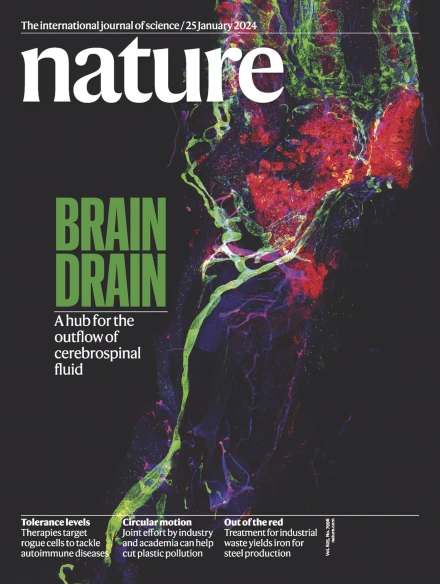中国晚侏罗世最早的短尾鸟
IF 48.5
1区 综合性期刊
Q1 MULTIDISCIPLINARY SCIENCES
引用次数: 0
摘要
最近的宏观进化研究预测了侏罗纪时期早期鸟类的多样化1 - 4,但毫无疑问的侏罗纪鸟类化石记录仅限于始祖鸟1,5,6,一些分析也将其称为恐爪龙恐龙7,8。虽然它们有羽毛翅膀,但已知的侏罗纪鸟类更类似于非鸟类兽脚亚目,因为它们有祖先的长长的爬行动物尾巴。这与大多数白垩纪和冠向分类群形成鲜明对比,后者的尾巴很短,末端是一根叫做尾柱的复合骨。本文报道了最近发现的晚侏罗世郑河动物群15中最古老的短尾鸟Baminornis zhenghensis gen. et sp. nov.,填补了最早分支鸟化石记录的明显时空空白。B. zhenghensis表现出独特的衍生鸟胸状胸腹带和非鸟形手盗龙手的组合,证明了沿着鸟形茎线的马赛克进化。根据我们的形态计量学和系统发育分析,在同一地点收集的一种鸟形动物的furcula可被称为鸟形动物。这些新发现的化石证明了高度衍生的鸟类特征的早期出现,并与同一地点的近鸟目化石一起,表明鸟类的起源更早,早期鸟类的辐射在侏罗纪。最近在晚侏罗世政和动物群中发现的两个鸟类化石表明,高度衍生的类鸟特征和鸟类的起源在侏罗纪时期出现的时间比以前估计的要早得多。本文章由计算机程序翻译,如有差异,请以英文原文为准。

Earliest short-tailed bird from the Late Jurassic of China
Recent macroevolutionary studies predict a diversification of early birds during the Jurassic period1–4, but the unquestionable Jurassic bird fossil record is limited to Archaeopteryx1,5,6, which has also been referred to deinonychosaurian dinosaurs by some analyses7,8. Although they have feathered wings, the known Jurassic birds are more similar to non-avialan theropods in having the ancestral long reptilian tail9–11. This is in stark contrast to most Cretaceous and crownward taxa, which have a short tail that terminates in a compound bone called the pygostyle12–14. Here we report on the oldest short-tailed avialan, Baminornis zhenghensis gen. et sp. nov., from the recently discovered Late Jurassic Zhenghe Fauna15, which fills a noticeable spatio-temporal gap in the earliest branching avialan fossil record. B. zhenghensis exhibits a unique combination of derived ornithothoracine-like pectoral and pelvic girdles and plesiomorphic non-avialan maniraptoran hand, demonstrating mosaic evolution along stem avialan line. An avialan furcula collected from the same locality is referrable to ornithuromorphs on the basis of our morphometric and phylogenetic analyses. These newly discovered fossils demonstrate the early appearance of highly derived bird features, and together with an anchiornithine fossil from the same locality, they suggest an earlier origin of birds and a radiation of early birds in the Jurassic. Two recently discovered bird fossils from the Late Jurassic Zhenghe Fauna demonstrate that highly derived bird-like features and the origin of birds appeared much earlier in the Jurassic period than previously estimated.
求助全文
通过发布文献求助,成功后即可免费获取论文全文。
去求助
来源期刊

Nature
综合性期刊-综合性期刊
CiteScore
90.00
自引率
1.20%
发文量
3652
审稿时长
3 months
期刊介绍:
Nature is a prestigious international journal that publishes peer-reviewed research in various scientific and technological fields. The selection of articles is based on criteria such as originality, importance, interdisciplinary relevance, timeliness, accessibility, elegance, and surprising conclusions. In addition to showcasing significant scientific advances, Nature delivers rapid, authoritative, insightful news, and interpretation of current and upcoming trends impacting science, scientists, and the broader public. The journal serves a dual purpose: firstly, to promptly share noteworthy scientific advances and foster discussions among scientists, and secondly, to ensure the swift dissemination of scientific results globally, emphasizing their significance for knowledge, culture, and daily life.
 求助内容:
求助内容: 应助结果提醒方式:
应助结果提醒方式:


